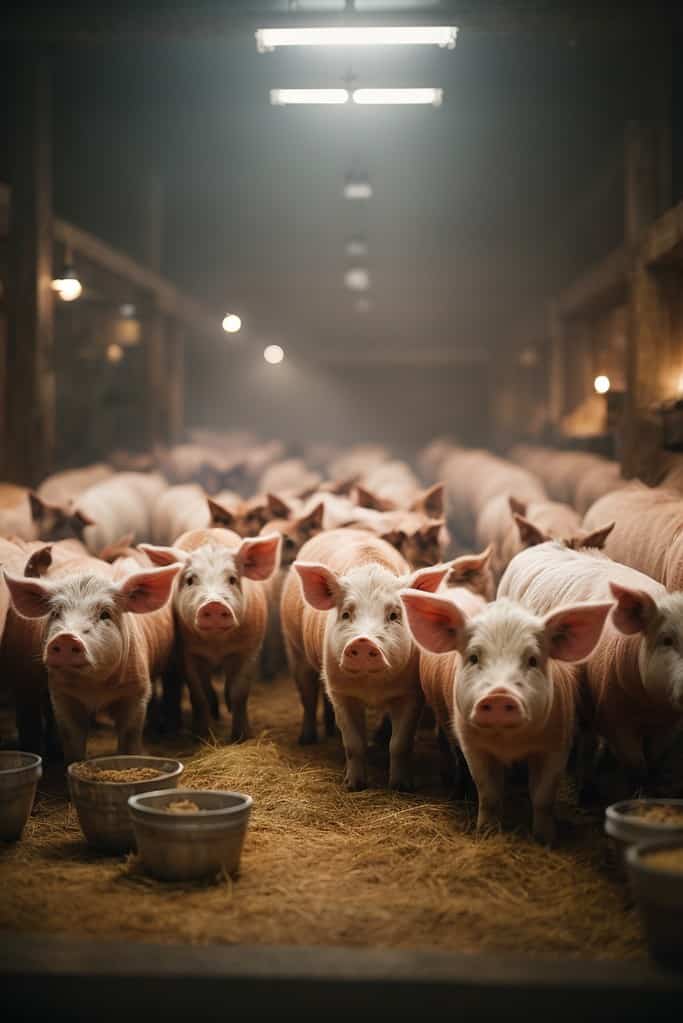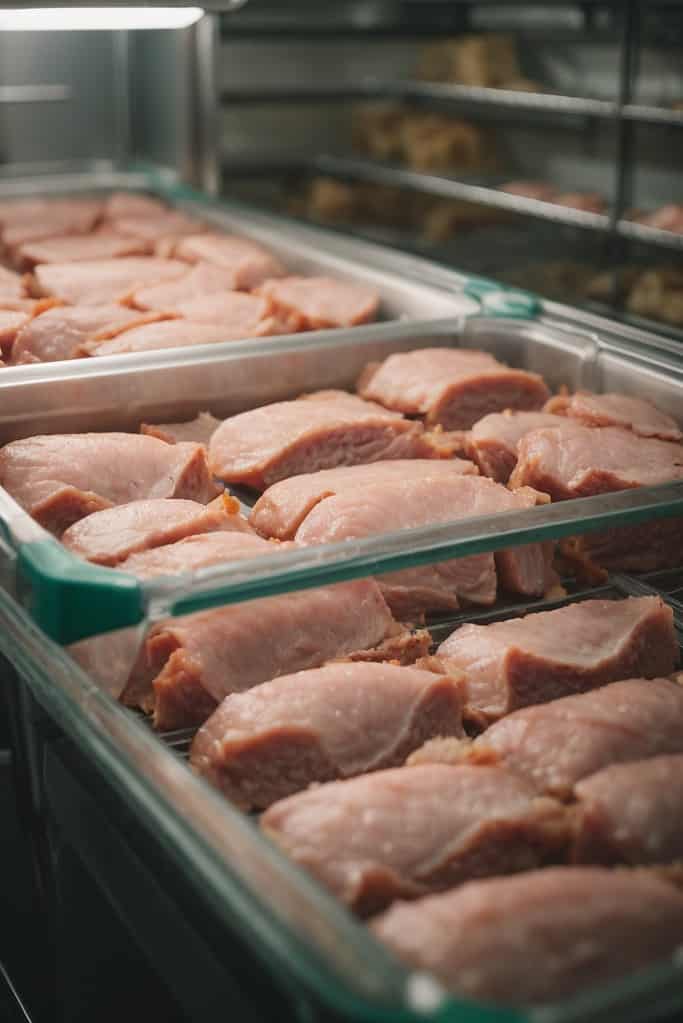Contents
Are you a pork lover? Do you often find yourself wondering how to properly select and store pork to ensure that it stays fresh and safe for consumption? Look no further! In this blog, we will dive into the basics of pork, including the different cuts and how to evaluate quality. We will also provide tips on how to choose the right cut, whether fresh or organic/free-range. But it doesn’t stop there; we will also cover safe handling procedures and common mistakes to avoid. Additionally, we’ll share tips on how to store pork correctly at ideal temperatures, both in the refrigerator and freezer. Lastly, we’ll discuss thawing frozen pork safely and how to tell if it has gone bad. And for those who love pulled pork, we’ll provide some tips on how to cook it to perfection. Read on to discover everything you need to know about selecting and storing pork like a pro!
Understanding the Basics of Pork
Pork, a versatile meat, can be cooked in various ways, including how to cook meat. Different cuts of pork offer different flavors and require varying cooking times. Proper handling and cooking techniques are crucial for food safety. Pork is a rich source of protein and essential nutrients. Enjoy it as roasts, chops, or ground meat, including the popular boston butt. Incorporating NLP terms like “grill,” “bacon,” “pork tenderloin,” and “pulled pork” enhances the content. From grilling to slow-cooking, there are many options for preparing pork. Understanding the basics of pork is essential for creating delicious and safe meals.

The Different Cuts of Pork
Pork cuts encompass an array of options, including tenderloin, loin, ribs, shoulder, and ham. Each cut possesses its own distinct characteristics and requires specific cooking methods. For grilling enthusiasts, pork chops are a popular choice, while pork roasts such as boston butt are ideal for slow cooking. Ground pork lends itself well to diverse recipes, such as meatballs or tacos. Understanding the different cuts empowers you to select the perfect one for your culinary endeavors. Enhance your knowledge of pork by exploring its various cuts and their unique attributes, including pork roasts.
Evaluating Quality in Pork
When selecting pork, look for cuts with marbling as it adds flavor and tenderness. Freshness can be determined by checking if the meat is firm and has a pink color. Avoid pork with excessive fat or dry patches. Choose cuts that are USDA inspected to ensure quality and nutrition. Proper packaging and refrigeration are crucial for maintaining the quality of pork. Evaluating the quality of pork involves considering these factors to ensure you get the best-tasting and safest product possible.
How to Choose the Right Pork Cut
When it comes to selecting the right pork cut, considering the cooking method is essential. For quick cooking methods, leaner cuts like pork tenderloin are ideal. On the other hand, fattier cuts such as shoulder or ribs are better suited for slow cooking, like braising. If you prefer more flavor and moisture, bone-in cuts are a great choice. Ultimately, the appropriate pork cut depends on the recipe and your personal preferences. Take these factors into account to ensure your pork dish turns out delicious and tender.

What to Look for in Fresh Pork
When selecting fresh pork, there are several things to look for. First, it should have a pleasant odor, without any foul smells. The meat should feel firm to the touch, not mushy or slimy. It’s also important to check the expiration date and look for the USDA inspection label, ensuring that it meets quality standards. Additionally, look for a good balance of lean meat and fat for optimal flavor. Once you’ve chosen your pork, be sure to refrigerate it promptly to maintain its quality.
Is Organic or Free-Range Pork Better?
When it comes to choosing between organic and free-range pork, there are a few factors to consider. Organic pork is raised without synthetic chemicals or hormones, while free-range pork comes from pigs with outdoor access. Both options prioritize animal welfare, so the decision ultimately depends on personal preferences and values. Consider factors like taste, price, and availability before making a choice.
Safe Handling of Pork
Proper handling of pork butt, a popular cut of meat, is essential to prevent foodborne illnesses, especially when cooking at high heat. Begin by practicing proper hygiene, such as washing hands before and after handling raw pork. To avoid cross-contamination, use separate cutting boards and utensils for pork. It’s crucial to cook pork to the recommended end cooking temperature using a meat thermometer to ensure doneness. When storing leftover pork, refrigerate or freeze it promptly to prevent bacterial growth. By following these safety measures, you can enjoy pork butt while minimizing the risk of foodborne illnesses.
Steps to Handle Pork Safely
To safely handle pork and poultry, it is important to keep raw pork separate from other foods in the grocery cart and during storage. When thawing frozen pork, use the refrigerator or microwave instead of room temperature. Ensure that pork is cooked thoroughly to kill any harmful bacteria and store cooked pork in shallow containers in the refrigerator within two hours. It is also crucial to clean and sanitize all surfaces and utensils used in handling raw pork to prevent cross-contamination. By following these steps, you can ensure the safe handling of pork.
Common Mistakes to Avoid in Handling Pork
To ensure safe handling of pork, there are several common mistakes that should be avoided. First, avoid rinsing raw pork as it can spread bacteria to other surfaces. Secondly, don’t rely on color alone to determine if pork is cooked properly; always use a meat thermometer to check for doneness. Additionally, overcooking pork can result in dry and tough meat, so it’s important to cook it just right. Remember not to leave cooked pork at room temperature for more than two hours and always use separate plates and utensils for raw and cooked pork.
How to Store Pork Correctly
To store pork correctly, it’s important to follow a few guidelines. Fresh pork should be stored in the refrigerator at or below 40°F (4°C) to prevent bacterial growth. For optimal freshness, use or freeze raw pork within a few days. When freezing pork, wrap it tightly in plastic wrap or freezer paper to prevent freezer burn. Properly labeled and dated frozen pork can be stored for several months. When thawing frozen pork, it’s best to do so in the refrigerator or using the defrost setting on a microwave.
Ideal Temperature for Storing Pork
To maintain the freshness and quality of pork, it is crucial to store it at or below 40°F. Refrigeration at this temperature helps prevent bacterial growth and ensures food safety. Store pork in the coldest part of the refrigerator, typically the back, as it maintains a consistently low temperature. To prevent cross-contamination, it is advisable to keep pork away from raw meats and seafood. Using a refrigerator thermometer helps monitor and control the temperature within the safe range. Remember, proper temperature control plays a vital role in preserving the quality and safety of pork.
How Long Does Pork Last in the Refrigerator?
Raw pork and sausage can be stored in the refrigerator for 2-4 days before cooking or freezing. Cooked pork and sausage can be safely refrigerated for 3-4 days. A 3-ounce serving of vacuum-sealed or tightly wrapped pork and sausage may last slightly longer. Always check for signs of spoilage before consuming refrigerated pork.
Storing Pork in the Freezer
To ensure the quality and safety of pork, it’s important to store it in the freezer at or below 0°F (-18°C). By properly wrapping the pork in airtight packaging, such as freezer bags or plastic wrap, including aluminum foil, you can prevent freezer burn and extend its shelf life. Don’t forget to label and date your pork packages so you can keep track of how long they’ve been frozen. When thawing frozen pork, it’s best to do so slowly in the refrigerator or under cold running water to prevent bacteria growth. Lastly, avoid refreezing thawed pork and cook it within 1-2 days for the best results.

Best Methods to Freeze Pork
To ensure the quality and freshness of frozen pork, it’s important to follow the best methods for freezing. Start by securely wrapping the pork in freezer paper or freezer bags to prevent freezer burn. Don’t forget to label and date the package so you know when it was frozen. For optimal results, freeze the pork as soon as possible after purchase. When it comes to thawing, it’s best to use the refrigerator or cold water, avoiding room temperature thawing. Lastly, make sure to use the frozen pork within 6 months for the best quality.
Does Freezing Affect the Quality of Pork?
Freezing pork can impact its quality if not done correctly. To maintain the quality, freeze pork at 0°F or lower. Thaw frozen pork in the refrigerator or cold water, avoid thawing at room temperature. Cook thawed pork immediately and never refreeze it.
Thawing Frozen Pork
Thawing frozen pork properly is essential to ensure safe and delicious cooking results. There are three common methods for thawing pork: refrigerator thawing, microwave thawing, and cold water bath. Each method has its own advantages and it’s important to choose the one that suits your needs. Regardless of the method you choose, make sure to allow enough time for the pork to thaw completely. It’s also recommended to use a meat thermometer to check the internal temperature before cooking. Once thawed, store the pork in the refrigerator or freezer within two hours to prevent the growth of harmful bacteria.
Safe Ways to Defrost Pork
When thawing pork, it is essential to prioritize safety to avoid bacterial growth. The most reliable method is thawing in the refrigerator, allowing enough time for the meat to fully defrost. If you’re pressed for time, you can opt for the microwave or cold water method, but be sure to cook the pork immediately afterward. It’s important to avoid thawing pork at room temperature as this can increase the risk of bacterial contamination. Once thawed, either cook the pork right away or store it in the refrigerator for up to three days. Always practice safe food handling when dealing with pork, including proper handwashing and cooking it to the recommended internal temperature.
Can Pork be Refrozen Once Thawed?
Can pork be refrozen once thawed? Refreezing pork is generally not recommended as it can negatively affect its quality and safety. When pork is thawed, the bacteria on it can start to multiply. Refreezing the meat can lead to further bacterial growth, increasing the risk of foodborne illness. It’s best to cook the pork after thawing it and consume it promptly.
How to Tell if Pork has Gone Bad?
If you want to determine whether pork has gone bad, there are a few indicators to look out for. Check for any unusual smell, such as a strong or unpleasant odor. Observe the color and texture of the meat – if it appears slimy, discolored, or sticky, it may be spoiled. Additionally, if the pork feels excessively soft or develops mold, it is best to discard it. Remember to always prioritize food safety when handling and consuming pork.
Frequently Asked Questions
What are some key factors to consider when selecting pork at the grocery store?
When selecting pork at the grocery store, there are several key factors to consider. Look for pink pork with a small amount of marbling, ensuring it is firm to the touch and not slimy or sticky. Check the sell-by date to ensure freshness, and choose cuts appropriate for your cooking method.
How should I properly store pork to ensure freshness and prevent spoilage?
To ensure the freshness and prevent spoilage of pork, store it in the fridge at a temperature of 40°F or below. Use or freeze fresh pork within 2-3 days of purchase. When freezing pork, make sure to wrap it tightly to prevent freezer burn. Also, always store raw pork separately from cooked foods to avoid cross-contamination.
Are there any safety precautions I should take when handling raw pork?
When handling raw pork, it’s important to take safety precautions. Always wash your hands and surfaces thoroughly before and after handling pork. Use separate cutting boards and utensils to avoid cross-contamination. Cook pork to the correct internal temperature of 145°F (63°C) to ensure it is safe to eat. Store raw pork in the refrigerator at 40°F (4°C) or below to prevent spoilage.
What are some common mistakes people make when selecting or storing pork?
Some common mistakes people make when selecting or storing pork include not checking the expiration date, storing pork at room temperature for too long, overcooking pork, and not properly sealing the packaging. It’s important to be mindful of these mistakes to ensure the quality and safety of your pork.
Conclusion
In conclusion, properly selecting and storing pork is essential to ensure its quality and safety. Understanding the different cuts of pork and evaluating its quality is the first step in choosing the right cut. Look for fresh pork that has a good color and firm texture. When it comes to storage, keep pork at the ideal temperature in the refrigerator or freezer to prolong its freshness. Follow safe handling practices to prevent any cross-contamination or foodborne illnesses. Thaw frozen pork safely and avoid refreezing it once thawed. Lastly, always check for signs of spoilage before consuming pork. By following these guidelines, you can enjoy delicious and safe pork dishes every time.

